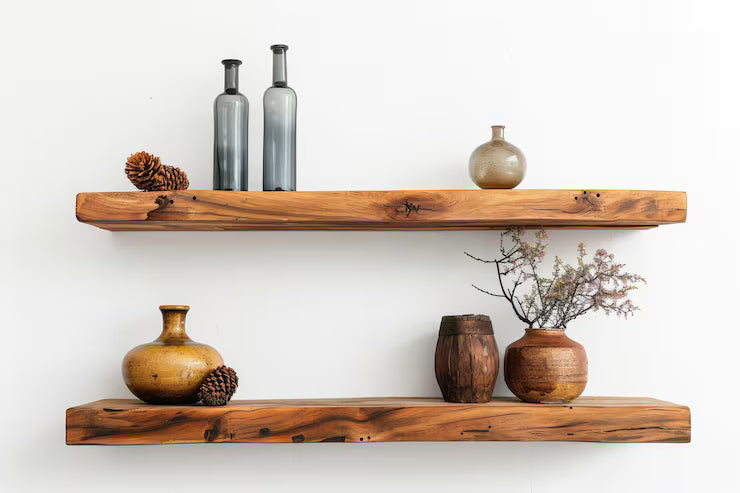Floating walnut shelves bring a sleek, timeless beauty to any room. The rich grain and deep color of walnut wood make it a standout choice, especially when used as open shelving in kitchens, offices, or living spaces. They’re built to support weight while keeping a clean, weightless appearance on your wall. But even though walnut is a strong and dense wood, time, use, and everyday exposure can leave their mark.
As months pass, you might start to notice small scratches, faded patches, or even subtle wobbling. These signs can creep in slowly, often from repeated handling, changes in humidity, or simply from day-to-day life. Keeping an eye on early wear and knowing what steps to take when it first appears helps you stretch the life and look of your shelf much longer. Some issues just need a quick fix, while others call for a more careful approach.
Identifying Signs of Wear and Tear
The first thing to do when your walnut shelf starts looking a bit tired is figure out what's going on. Small changes are easier to manage when caught early, and keeping track of the condition helps you decide when it’s time to act.
Here are some typical signs to watch for:
- Light scratches or surface scuffs, especially where items are moved or slid regularly
- Fading or discoloration in areas that get direct sunlight or strong indoor lighting
- Dull patches from buildup, leftover cleaning products, or contact with water
- Loose brackets or screws that make the shelf feel slightly off-balance
- Gaps between the shelf and the wall from movement or wood shifting over time
Environmental conditions can play a big role in how quickly these things show up. For example, changes in temperature and humidity levels can cause natural wood to expand or contract. In homes where the AC or heat runs often, dry air might slowly dry out the wood finish, leading to cracking or minor warping. On the flip side, too much humidity can cause brackets to loosen or your shelf to feel less secure than before.
A shelf that’s placed near a sink, vent, or window might show signs of wear sooner than one tucked away in a still, shaded spot. Pay attention to where the shelf is mounted and how things like steam, grease, or heat could be reaching it. Sometimes, wear shows up just from repeated jar scraping or the weight of heavy objects sitting in the same place for too long.
Even if it looks like small stuff, these early indicators matter. They affect both how the shelf looks and how well it works. Getting ahead of the wear lets you avoid bigger repairs or trouble later on.
Immediate Actions to Take When Wear Appears
Once you notice signs of wear, don’t wait too long to do something about it. Light wear often just needs a bit of care to get things back in order. Acting quickly can help prevent more damage or at least buy you some time until a pro can take a look.
Start with a quick clean. Dust and grime can hide damage or make it seem worse than it is. One of the easiest ways to make a shelf look better is to gently wipe it down with a clean, soft cloth. Avoid overly wet cloths or chemical-based sprays. Walnut has a natural finish and harsh products can do more harm.
Then take these steps:
1. Spot polish any small scratches using a wood-safe polish or walnut-toned touch-up marker.
2. Tighten screws or brackets if you feel any wobble. Make sure there’s no movement between the shelf and wall.
3. Shift heavy or sharp items around. Try not to let the same object sit in the exact spot day after day.
4. Place felt furniture pads or small coasters under items to protect the surface.
5. Use a table lamp or dimmable light to reduce glare and slow down fading from direct light.
If the shelf has become unstable or the damage looks deep, like cracking, major discoloration, or warping, it’s best to stop using it for the time being. That keeps things safe and avoids extra damage. You can take pictures of the problem areas and store the items elsewhere until you decide whether repair or replacement is the right step.
These small fixes won’t solve deeper problems, but they help hold the line. Caring right away helps you keep things presentable and functioning until someone with proper tools and training can step in.
Preventive Measures to Maintain Shelf Longevity
Taking small steps to care for your floating walnut shelf pays off over time. While walnut is strong, consistent maintenance keeps the finish even and the structure stable. It doesn’t take much to keep your shelf looking good, but skipping care for too long can invite problems that are harder to reverse.
Start with the basics. Dust regularly using a dry microfiber cloth. That helps prevent grit from scratching the surface. If fingerprints or grease show up, lightly dampen the cloth with water. No need for cleaners unless there’s a stain, and even then, skip anything chemical. Stick with something mild and gentle if you must use a cleaner at all.
Placement plays a bigger role than most people think. Where you install the shelf can determine how fast it wears down. A spot that’s always getting sunlight can fade quicker. A wall close to a stove or heating vent might lead to faster drying and cracking in the wood. Avoid mounting your shelf in areas exposed to steam or moisture buildup, like above a kettle or near a shower entrance. These spots create long-term issues that don’t always show right away.
There’s also the issue of weight. Make sure the shelf isn’t overloaded with books or heavy decor. Try spreading everything evenly and avoid stacking more than one layer of anything dense. If you’re not sure how much is too much, think about what the shelf is fastened to, and don’t pass the point where it starts to flex or pull away from the wall.
Here’s a general list to follow for routine care:
- Dust weekly with a soft, dry cloth
- Clean spills quickly using a lightly dampened cloth, then dry right after
- Use coasters or felt pads under decor to avoid scratching
- Keep shelf clear of heat, moisture, and direct sunlight where possible
- Rotate stored items every month or so to keep pressure from wearing down one spot
All of this might add just a couple of minutes to your week, but it makes a real difference. A well-maintained shelf holds up longer, looks sharper, and works better in daily use.
Knowing When to Seek Professional Help
Even with great care, there may come a time when the wear goes beyond surface scratches or loose hardware. That’s when it’s smart to bring in someone who knows how to restore wood or assess structural concerns. Trying to patch something major without the right materials or background might do more harm than good.
If your floating walnut shelf has deep cracks, serious discoloration, or water stains that won’t wipe away, it probably needs more than a polish. Warping is another red flag. If one side starts lifting or the shelf isn’t flush with the wall anymore, weight distribution could be off, especially if it’s holding a lot. It may even signal that the wall fasteners are wearing out, which can get unsafe if ignored.
A local woodworker or furniture repair specialist can usually handle these types of repairs. Look for someone who works with solid wood and understands both cosmetic and structural fixes. You can ask about their experience with floating shelves in particular. If the walnut needs to be refinished, the tone and grain should still match what you’ve got, and a pro will know how to do that without sanding too far or applying the wrong type of coating.
One homeowner shared how their long walnut shelf near the kitchen window developed both fading and a slight dip in the middle after two years. They ended up having the shelf refinished and reinforced with hidden support brackets by a repair tech. It gave the piece a second life and actually made it stronger without changing how it looked from the outside.
Temporary fixes can only stretch so far. If the shelf isn’t safe, doesn’t sit level, or simply looks beyond light repair, it’s time for someone skilled to step in.
Keep Your Shelf Looking Great
Floating walnut shelves add warmth and luxury to any space, but keeping them in good shape takes some active care. The good news is most wear starts small, giving you plenty of chances to address it early. By keeping an eye on signs like scratches, discoloration, and shifting brackets, you can jump in with simple fixes before the damage gets worse.
More importantly, a bit of routine upkeep, from dusting and shifting items to choosing the right spot for installation, goes a long way in keeping your shelf beautiful and dependable. You're not just preserving looks, you're preventing the kind of wear that turns into expensive repairs later.
If the shelf does begin showing more serious signs of wear, getting a professional involved helps extend its life or at least gives you clear options moving forward. Whether it needs reinforcement or a fresh finish, having someone familiar with solid walnut work on it makes all the difference.
With the right balance of care, monitoring, and smart action, your shelf can stay strong and stylish for years to come. Treat it like a part of your space, not just an object on the wall, and it’ll keep delivering both form and function.
Keep your walnut shelf looking as beautiful as the day it was installed with the right care and attention. At The Mortise & The Hare, our shelving is designed to last, but knowing how to preserve your floating walnut shelf can make all the difference. Explore our collection to find options that bring both warmth and practicality to your space.




Share:
Organizing Your Spices on a Gallery Rail Kitchen Shelf
Protecting Live Edge Oak Shelves from Sun Damage